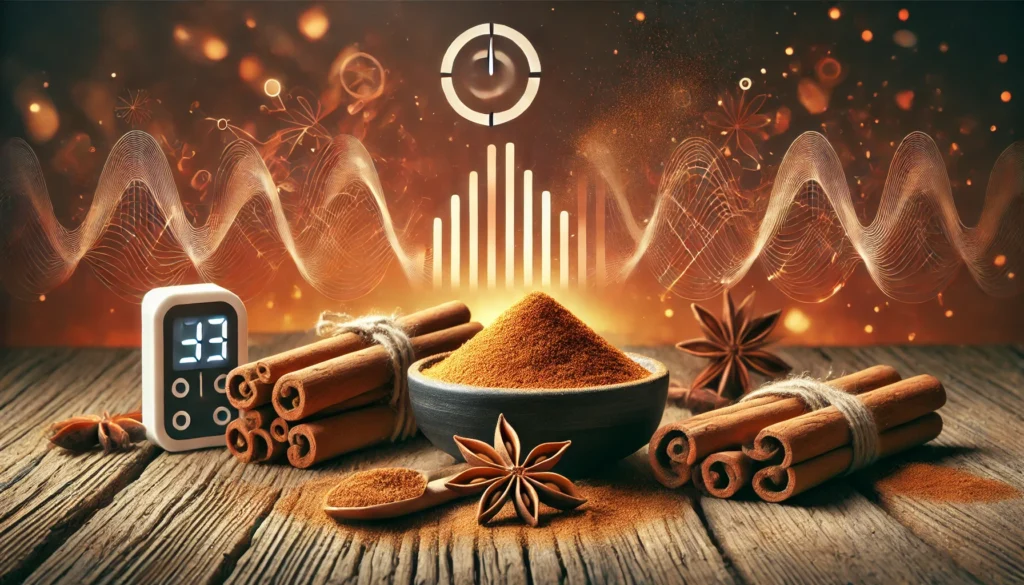Cinnamon, a spice cherished for its flavor and aroma, has increasingly been recognized for its potential health benefits. Among its many uses, cinnamon is gaining attention for its role in regulating blood sugar levels, making it particularly significant for individuals managing conditions like diabetes. Additionally, the spice boasts powerful antioxidant properties, contributing to overall well-being by combating oxidative stress in the body. This article explores the science behind cinnamon’s ability to stabilize blood sugar, the mechanisms involved, and its antioxidant benefits, offering a comprehensive look at why this ancient spice may be key to modern health management strategies.
1. Introduction to Cinnamon
Cinnamon, a popular spice known for its distinct flavor and aroma, has garnered attention for its potential health benefits. Derived from the inner bark of trees belonging to the Cinnamomum genus, cinnamon has been used for centuries in traditional medicine and culinary practices. Its versatility extends to both sweet and savory dishes, making it a staple in various cuisines around the world. Furthermore, research has delved into the impact of cinnamon on blood sugar levels and its antioxidant properties, shedding light on its potential role in promoting health and wellness [1].
Cinnamon’s rich history and widespread use provide a compelling backdrop for exploring its potential impact on health. As we delve deeper into its properties, it becomes evident that cinnamon holds promise as a natural remedy with a range of potential health benefits.
2. Understanding Blood Sugar Regulation
Understanding blood sugar regulation is crucial for comprehending the potential impact of cinnamon on stabilizing blood sugar levels. The body tightly regulates blood glucose through a complex interplay of hormones, primarily insulin and glucagon. When blood sugar levels rise after a meal, the pancreas releases insulin to facilitate the uptake of glucose by cells for energy or storage. On the other hand, when blood sugar levels drop, the pancreas releases glucagon to stimulate the release of stored glucose into the bloodstream. This delicate balance is essential for overall health and is perturbed in conditions like diabetes.
Numerous studies have investigated the potential of cinnamon in influencing blood sugar regulation. For instance, research by Sahib [2] demonstrated that cinnamon can improve blood glucose and lipid profiles in type 2 diabetic individuals, potentially reducing risk factors associated with diabetes and cardiovascular diseases. Additionally, Medagama [1] highlighted the controversies surrounding the clinical potential of cinnamon for managing diabetes, emphasizing its impact on glucose, insulin, and cholesterol levels. These findings underscore the importance of understanding blood sugar regulation and the potential role of cinnamon in this intricate physiological process.
3. Antioxidants and their Impact on Health
[3]. Additionally, cinnamon has been linked to cardiovascular effects, including increased coronary blood flow, reduced peripheral vascular resistance, and improved lipid profile by decreasing total cholesterol, triglycerides, and LDL-C levels, while increasing HDL-C [4].
These findings underscore the potential health benefits of cinnamon’s antioxidant properties, highlighting its significance in promoting overall well-being and potentially aiding in the management of various health conditions. Further research is recommended to gain a deeper understanding of the antioxidant and health effects of cinnamon, especially in the context of its potential applications in food preservation and human health.
4. Historical and Cultural Significance of Cinnamon
Cinnamon has a rich historical and cultural significance that dates back to ancient societies. It was highly valued in various cultures for its aromatic fragrance, medicinal properties, and use in religious ceremonies. In ancient Egypt, cinnamon was used in embalming rituals, while in ancient Rome, it was a symbol of luxury and abundance. The spice also held cultural significance in traditional Chinese medicine and Ayurveda, where it was used to treat various ailments and imbalances in the body [5].
The enduring relevance of cinnamon in modern times can be attributed to its historical and cultural significance, which has contributed to its widespread usage today. Understanding the deep-rooted cultural and historical importance of cinnamon provides valuable context for appreciating its multifaceted role, including its potential as an adjunct to regular medications and its antioxidant properties [1].
5. Chemical Composition of Cinnamon
Cinnamon is a complex spice with a rich chemical composition that contributes to its potential health benefits. Research has shown that cinnamon contains compounds such as catechin, epicatechin, and proanthocyanidins, which act as reactive carbonyl scavengers, reducing the formation of advanced glycation end products (AGEs) during digestion [6]. Additionally, different types of cinnamon have been found to inhibit digestive enzymes, with Chinese cinnamon showing strong activity against α-amylase, and all types potently inhibiting α-glucosidase activity.
Furthermore, clinical trials have demonstrated the potential of cinnamon to improve blood glucose levels in individuals with type 2 diabetes. Studies have shown that daily administration of cinnamon resulted in significant reductions in fasting plasma glucose (FPG) levels, HbA1c levels, and improvements in lipid profiles [2]. These findings suggest that the chemical composition of cinnamon plays a crucial role in its potential to stabilize blood sugar levels and positively impact overall health.
6. Mechanisms of Action in Blood Sugar Regulation
In understanding how cinnamon influences blood sugar regulation, it’s essential to delve into the mechanisms of action involved. Studies have shown that cinnamon extract enhances glucose uptake in adipocytes and myocytes by inducing LKB1-AMP-activated protein kinase signaling [1]. Additionally, cinnamon may affect blood glucose levels by influencing the insulin-signaling pathway, insulin receptor phosphorylation, and the translocation of glucose transporter GLUT4 [2]. Furthermore, the spice has been found to increase the level of glucagon-like peptide 1, inhibit intestinal α-glucosidase, inhibit gluconeogenesis, stimulate glycogen synthesis, and potentially delay gastric emptying, all of which contribute to the reduction in post-prandial blood glucose. These mechanisms shed light on how cinnamon’s components interact with the body to potentially impact blood glucose levels.
7. Clinical Studies on Cinnamon and Blood Sugar
Numerous clinical studies have been conducted to investigate the impact of cinnamon on blood sugar levels, particularly in individuals with type 2 diabetes. These studies have largely focused on cinnamon’s potential to improve insulin sensitivity, lower fasting blood glucose levels, and reduce HbA1c, a key marker of long-term blood sugar control. For example, a randomized, placebo-controlled clinical trial conducted by Salih Sahib [2] revealed that patients who consumed cinnamon experienced significant reductions in fasting plasma glucose, HbA1c, and total cholesterol compared to those who received a placebo. This suggests that cinnamon may be effective as a complementary treatment for managing blood sugar in diabetic patients.
Another notable study by Medagama [1] reviewed the experimental evidence and clinical trials surrounding cinnamon’s glycaemic outcomes. The study found that cinnamon not only improved glycaemic control but also had a positive effect on lipid profiles, potentially reducing cardiovascular risk factors in patients with type 2 diabetes. However, the study also highlighted the need for further research, as there are still controversies surrounding the appropriate dosage, duration of treatment, and the species of cinnamon that yields the most significant benefits.
These clinical findings provide promising evidence that cinnamon could play a beneficial role in managing blood sugar levels, particularly for individuals with diabetes. However, more extensive studies are needed to confirm the long-term efficacy and safety of cinnamon as a therapeutic supplement. [2]
8. Potential Side Effects and Risks
Potential side effects and risks associated with the consumption of cinnamon should be carefully considered, especially for individuals with underlying health conditions. Research has indicated that the use of cinnamon, particularly ‘true’ cinnamon (Cinnamomum zeylanicum), may lead to inflammatory responses in some individuals [1]. Additionally, a study [7] highlighted the potential of cinnamon as a dietary supplement to cause hyperlipidemia in healthy rats, emphasizing the need for cautious use, particularly in the context of metabolic disorders. It’s important to note that while cinnamon has demonstrated blood glucose-lowering effects, its efficacy in counteracting complex risk factors and its influence on blood lipid profiles warrant further investigation, particularly in the absence of disease.
These findings underscore the importance of understanding the potential side effects and risks associated with the use of cinnamon, particularly in the context of its role in stabilizing blood sugar levels.
9. Forms of Cinnamon Supplementation
Cinnamon can be consumed in various forms, offering flexibility in integrating it into daily routines. One common form is through capsules, which provide a convenient and measured dosage of cinnamon extract. Additionally, cinnamon extracts are available, offering a concentrated form of the spice for supplementation. For those who prefer traditional culinary uses, cinnamon can be incorporated into meals, smoothies, or teas, allowing for a flavorful and versatile approach to supplementation [1].
In a clinical trial, cinnamon was administered in different forms, including aqueous extract and cassia powder, showcasing its diverse applications in managing blood glucose levels and improving insulin sensitivity in type 2 diabetic patients [2]. These diverse forms of supplementation cater to individual preferences and dietary habits, making it easier for individuals to incorporate cinnamon into their daily regimen.
10. Culinary Uses of Cinnamon
Cinnamon is a versatile spice that is widely used in various culinary applications, from traditional to modern cooking and baking practices. Its rich and warm flavor makes it a popular choice for sweet and savory dishes alike. Whether it’s sprinkled on oatmeal, added to baked goods, or used in savory stews, cinnamon adds a distinct and delightful taste to a wide range of recipes [8].
The use of cinnamon in culinary practices is not only for its flavor, but also for its potential health benefits. Studies have highlighted the antioxidant, anti-inflammatory, and antimicrobial properties of cinnamon, making it not just a flavorful addition to dishes, but also a potentially health-promoting ingredient [5].
11. Conclusion and Future Directions
In conclusion, the exploration of cinnamon’s role in stabilizing blood sugar levels and its antioxidant properties presents promising avenues for future research and practical applications. The experimental evidence and clinical trials reviewed suggest controversies surrounding the clinical potential of cinnamon for diabetes management, while also highlighting the potential of cinnamon extract to enhance glucose uptake and lower glucose, insulin, and cholesterol levels in individuals with elevated serum glucose [1]. Furthermore, recent evaluations of the antioxidant potential of cinnamon have demonstrated its high antioxidant capacity and vasodilatory activities, emphasizing its importance in the diet and its potential to reduce oxidative damage caused by free radicals [9].
These findings underscore the need for further research to fully understand the mechanisms underlying cinnamon’s effects on blood sugar levels and its antioxidant properties, as well as its potential implications for healthcare and wellness. Moreover, the practical applications of cinnamon in managing diabetes and promoting overall health warrant continued exploration and development.
References:
[1] A. B. Medagama, “The glycaemic outcomes of Cinnamon, a review of the experimental evidence and clinical trials,” 2015. ncbi.nlm.nih.gov
[2] A. Salih Sahib, “Anti-diabetic and antioxidant effect of cinnamon in poorly controlled type-2 diabetic Iraqi patients: A randomized, placebo-controlled clinical trial,” 2016. ncbi.nlm.nih.gov
[3] M. Zia Shahid, H. Saima, A. Yasmin, M. Tahir Nadeem et al., “Antioxidant capacity of cinnamon extract for palm oil stability,” 2018. ncbi.nlm.nih.gov
[4] H. R Vasanthi and R. P. Parameswari, “Indian Spices for Healthy Heart – An Overview,” 2010. ncbi.nlm.nih.gov
[5] P. Kawatra and R. Rajagopalan, “Cinnamon: Mystic powers of a minute ingredient,” 2015. ncbi.nlm.nih.gov
[6] N. J. Hayward, G. J. McDougall, S. Farag, J. William Allwood et al., “Cinnamon Shows Antidiabetic Properties that Are Species-Specific: Effects on Enzyme Activity Inhibition and Starch Digestion,” 2019. ncbi.nlm.nih.gov
[7] X. Huang, H. Cai, H. Li, Y. Su et al., “Cinnamon as Dietary Supplement Caused Hyperlipidemia in Healthy Rats,” 2021. ncbi.nlm.nih.gov
[8] J. Kowalska, J. Tyburski, K. Matysiak, M. Jakubowska et al., “Cinnamon as a Useful Preventive Substance for the Care of Human and Plant Health,” 2021. ncbi.nlm.nih.gov
[9] E. K. G. Moreno, I. Y. L. de Macêdo, E. A. Batista, F. B. Machado et al., “Evaluation of Antioxidant Potential of Commercial Cinnamon Samples and Its Vasculature Effects,” 2022. ncbi.nlm.nih.gov

